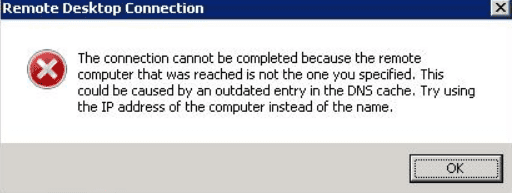‘RDP outdated entry in the DNS cache’ error occurs while connecting to the RDS (Remote Desktop Server) farm running Windows Server 2008 R2 using the standard RD client (mstsc.exe).
Here at Bobcares, we have seen several such Windows-related errors as part of our Server Management Services for web hosts and online service providers.
Today we’ll take a look at the causes for this error and see the fix.
What causes ‘RDP outdated entry in the DNS cache’ problem to arise
This RDP error occurs while connecting to the RDS farm running Windows Server 2008 R2 using the standard RD client. For instance, the error appears as below.

The configuration of the RDS farm comprises 3 servers running Windows Server 2008 R2 with RD Connection Broker used to distribute workload between the terminals and to reconnect to the current sessions.
Since this error occurs from time to time suggests that the problem is with one of the servers of the farm.
How we resolve the problem ‘RDP outdated entry in the DNS cache’
We saw how the error occurs. Now let’s take a look at the resolution part and see how our Support Engineers resolve this error for our customer.
First, we run the server record registration in DNS. For that, we run the below command.
ipconfig /registerdnsNext, we reset the local DNS cache on the client in a couple of minutes by running the below command.
ipconfig /flushdnsAfter that, we reduce the level of the protocol used to encrypt the RDP connection from SSL to RDP Security Layer.
This setting is located in Remote Desktop Session Host Configuration >> Microsoft RDP 7.1 >> Properties >> Security Layer
But we found that in the configuration, the Negotiate method is used. It uses automatic switching from TLS to RDP Security Layer if the client does not support the first method.
Also, the time on the problem server differs from the domain controller time. Moreover, we found that this server was located on the VMWare ESXi host at the wrong time. Also, the option of time synchronization with the host hypervisor was enabled in VMWare Tools settings.
So we disabled ESXi synchronization and restarted Windows Time Service to synchronize time with the DC.
net stop w32time net start w32timeAfter that, the customer was able to connect to all servers of the RDS farm without any errors.
[Need any further assistance in fixing Windows errors? – We are here to help you]
Conclusion
In short, this error occurs while connecting to the RDS farm running Windows Server 2008 R2 using the standard RD client. Today, we saw the solution provided by our Support Engineers.



0 Comments